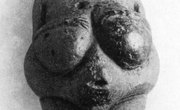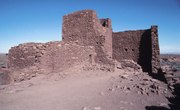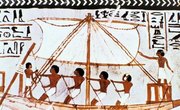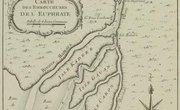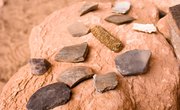Over millions of years, tools evolved from prehistoric stone weaponry to modern supercomputers. Tools dramatically impact a human's ability to withstand changing local conditions and flourish despite the odds. Human ingenuity is evident in the simple but effective tools that helped nomadic Paleo Indians endure the brutal conditions of the ice age. When glaciers eventually receded and the earth warmed up, indians of the Archaic period faced a different set of challenges. Large animals once hunted became extinct, eliminating the hunter-gatherers' major food source. In response, the hardy descendants of Paleo Indians enhanced the tools of the ancients and developed many new ones to tap all their natural resources.
Tip
Archaic Indians improved upon the crude stone tools of the ice age Paleo Indians. They developed lighter, faster darts launched with a spear thrower called an atlatl. Fish hooks, nets, baskets and the bow and arrow emerged as the tribal lifestyle became less nomadic.
Understanding Why Tools Matter
Tools offer archaeologists a glimpse into the everyday world of early humans. Although some bird and animal species use objects as tools, Homo sapiens possess the unique ability to assess raw materials at hand and invent tools for very specific purposes. Analyzing tool-making techniques provides a fascinating look at what life was like when man coexisted with dire wolves and other large, frightening creatures. Although primitive in comparison to modern weaponry, Paleo Indian spear tips served their purpose well in the ice age. Tools enabled Archaic Indians to adapt to dramatically changing environmental conditions when the planet warmed and new food sources were needed.
Who Were the Ancient Indians?
Ancient Indians started colonizing the Western Hemisphere late in the Pleistocene epoch about 14,000 years ago around the time of the ice age. World geography looked quite different from the demarcated continents of today. Northern Eurasia and America were coated with thick sheets of ice and expansive glaciers. Ocean levels fell, exposing previously submerged land masses that bridged the continents. Plant species, animals and rugged people are believed to have used this route to migrate from Siberia to Alaska. This span of time in North American history is known as the Paleo Indian period. Artifacts such as the distinctive spear point of Paleo Indians make it possible to identify migration routes of Paleo people throughout the Americas.
Paleo Indian Way of Life
The Paleo period, which spanned 12,000 – 10,000 B.C. as estimated by the National Park Service, was an ongoing test of survival. Paleo Indians spent their days hunting for and fleeing from towering beasts that are now extinct. Armed only with stone-tipped swords, Paleo Indians faced megafauna (large animals) such as saber-toothed tigers, bears, mastodons, American lions and mammoths. Base camps were set up for hunting purposes, and areas were designated for processing meat and hides. Paleo people used many parts of the animal for food, fur robes, moccasins and shelter.
What Tools Did Paleo Indians Use?
Toolmaking was a serious undertaking during the ice age. Paleo Indians traveled up to 300 miles in search of quality materials for tools. Paleo Indians used a heavy rock called a hammer stone to knap a smaller stone into a desired shape. The goal was to fashion a tool with sharp edges that could be used for hunting, self-defense or cutting chunks of meat. Sharp scrapers aided in the cleaning of hides and pelts after a successful hunt. Animal skins offered vital protection from the bitter cold. Paleo people used an awl to make holes in fur scraps before stitching them together.
What Weapons Did the Paleo Indians Use?
Paleo Indians are known for beautiful, intricate and highly effective projectile points. Among the oldest designs are Clovis points with a chiseled-out groove in the middle and jagged edges. The center flute helped affix the tip to a spear. Paleo Indians quickly figured out that cryptocrystalline stone like chert, jasper and certain types of quartz are ideal materials for spearheads because they can be chipped without disintegrating and retain a razor-sharp edge. Paleo Indians carefully transported their valuable weapons from one encampment to the next as the tribe followed the seasonal migration of animals. Stone tips found in the U.S. appear similar to those used during this period in Siberia, supporting the assertion that indigenous people came to the U.S. from Asia.
Paleo Indian Settlements
Like other nomadic hunter-gatherers, Paleo Indians didn’t construct permanent homes. Groups of families lived in circular-shaped dwellings constructed with poles tied together in a shape of a teepee. Brush, mud and animal furs were wrapped around the poles for insulation. An animal hide hung over the entryway. A fire pit was added for warmth and cooking game. Social organization was loose. Typically, there were no chiefs or other formal leaders. Expert hunters were held in high regard and likely influenced decisions about staying or leaving a particular spot.
Who Were the Archaic Indians?
The Archaic period marked the end of the ice age. Like their Paleo Indian ancestors, Native Americans living in the Archaic period were largely hunter-gatherers. However, global warming necessitated significant lifestyle changes. Large game became extinct, so they turned to deer, bison, rabbits, fish and birds for subsistence. Archaic Indians also added more nuts, fruits, tubers and berries to their diet. Toward the end of the Archaic period, Archaic Indians started growing cultivated crops. As food insecurity became less of a concern, tribes became larger and more location-bound.
Archaic Indian Way of Life
Many different indigenous cultures populated the New World during the Archaic period. A common characteristic was less reliance on hunting and greater utilization of local natural resources. Lodges were sturdier, food storage methods were developed and tribes started trading with one another. Woodland tribes felled trees and made dugout canoes, which opened up exploration and expanded fishing opportunities. Regional plants like yucca, pine nuts, amaranth greens and rice grass seeds provided food for people of the Southwest.
What Tools Did Archaic Indians Use?
Adaptation to changing climatic conditions demanded new and improved tools. Regional differences factored into the distinctive style of tools that emerged. Archaic Indians adjusted their diets and lifestyle accordingly. For instance, coastal Indians developed fish hooks and nets for catching fish. Abundant acorns provided a reliable food source for forest inhabitants. Mortars and pestles were used to grind acorns, nuts and hard seeds. Baskets were essential for gathering and storing edible plants. Because Archaic Indians didn’t typically travel as far or as often as their ancestors, they dug pits for storing food, which helped them adjust to changing seasons.
What Weapons Did Archaic Indians Use?
Preferred weapons of the Archaic period changed slightly during the early, middle and late subperiods. In the Early Archaic period around 8,000 B.C., a new type of spear thrower called an atlatl came into popular use. The atlatl was a wooden stick with a wooden handle and a hook on the other end that catapulted darts at prey or enemies. The atlatl enabled hunters to launch their spears from longer distances with greater accuracy. In the middle and late subperiods, the chunky spear points of the early Archaic period were replaced by smaller, lighter darts that could fly faster. Flint was a valuable natural resource used in spears and darts. The bow and arrow emerged in the late Archaic period.
Archaic Indian Settlements
As tribes became less nomadic, social organization became more structured. Family groups clustered in certain regions and built more durable shelters. Dogs were domesticated. The dead were buried in cemeteries. Burial rituals varied according to the age, gender and social status of the deceased. Later in the Archaic period, Indians started planting corn and squash. Seeds were shared with other tribes, and agricultural production became more common. Pottery making emerged, which is typically associated with farming cultures.
Related Articles
References
- Crow Canyon Archaeological Center: Archaic Food
- Crow Canyon Archaeological Center: Peoples of the Mesa Verde Region
- Illinois State Museum: Archaic
- Illinois State Museum: Archaic Technology: Tools & Utensils
- Milwaukee Public Museum: Archaeological History
- National Park Service: Paleoindian Period 12,000-10,000 BC
- Ohio History Central: Archaic Period
- Smithsonian.com: The Clovis Point and the Discovery of America's First Culture
- University of Iowa Office of the State Archeologist: Ground Stone Artifacts
- Virginia Places: Paleo-Indians in Virginia
Writer Bio
Dr. Mary Dowd is a dean of students whose job includes student conduct, leading the behavioral consultation team, crisis response, retention and the working with the veterans resource center. She enjoys helping parents and students solve problems through advising, teaching and writing online articles that appear on many sites. Dr. Dowd also contributes to scholarly books and journal articles.




